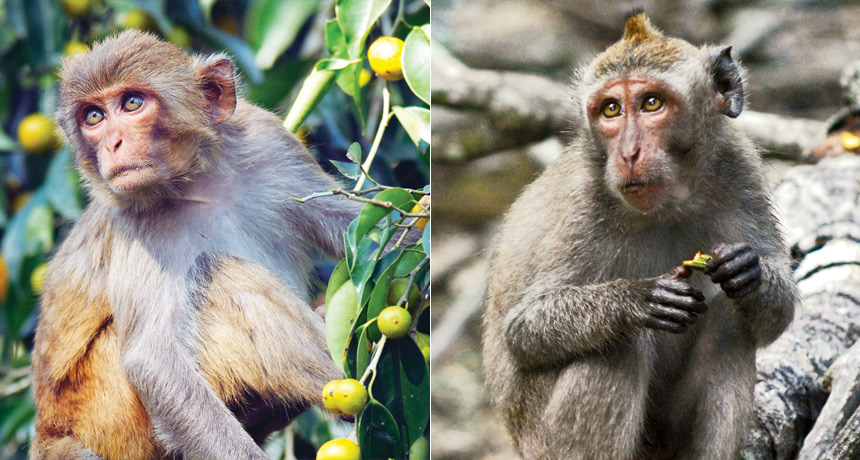Airborne transmission of Ebola unlikely, monkey study shows
No evidence found of macaques passing deadly virus to each other

CONTAINED Rhesus macaques (left) infected with Ebola in a laboratory experiment could not pass the virus through the air to cynomolgus macaques (right).
Vijay Anand Ismavel/Flickr (CC BY-NC-SA 2.0); © Andrea Cantú/iNaturalist.org (CC BY-NC)
- More than 2 years ago
Monkeys do not pass Ebola to one another through the air, researchers report. The result confirms observations of human outbreaks: Infection with the deadly virus requires contact with bodily fluids.
The study follows up on a 2012 report that raised concerns Ebola might be able to spread by air (SN: 12/15/12, p. 12). That study, led by infectious disease researcher Gary Kobinger of the Public Health Agency of Canada, found that macaques contracted Ebola when housed in cages near a pen containing piglets infected with Ebola. The animals never touched. The researchers said the finding meant that the virus probably floated to the monkeys’ cages as a fine airborne spray of particles shed by the pigs.
Pigs seem to give off more aerosolized viral particles than other species, says Derek Gatherer, a viral evolutionary biologist at Lancaster University in England. “If it’s going to spread by aerosols, then pigs are the species to do it,” he says.
But he doesn’t think the researchers definitively demonstrated airborne transmission of the Ebola virus. Virus-laden droplets of water could have splashed from the pig pen to the macaque cages when the researchers washed the pig enclosure, he says.
Pigs probably aren’t a source of Ebola outbreaks. Few have even been found to carry Ebola. Pigs in the Philippines have been found to carry Reston ebolavirus, a species of Ebola that does not cause disease in people. No African pigs are known to be infected with Zaire ebolavirus, the cause of the current epidemic.
Even if pigs can transmit the virus by air, they may be unique in the ability. The new study, published July 25 in Scientific Reports by Kobinger and a different group of collaborators, found no evidence that sick macaques could give the virus to healthy monkeys through airborne particles.
The researchers placed two rhesus macaques infected with Zaire ebolavirus in cages near two uninfected cynomolgus macaques. The animals couldn’t touch, but no special shielding protected the uninfected monkeys. The infected monkeys died after six days. Meanwhile, the cynomolgus macaques remained free of Ebola for the entire 28 days of the experiment, well beyond the six to 16 days it takes for symptoms to appear after catching Ebola.
Since December 2013, this largest ever outbreak of Ebola has killed at least 932 people — more than half of the 1,711 people infected — in the West African nations of Guinea, Liberia, Sierra Leone and Nigeria. Those infected include two American health care workers who treated people with the deadly disease. The two sick Americans, Kent Brantly and Nancy Writebol, have been transferred to Atlanta for treatment in an isolation facility at Emory University Hospital.
Fabian Leendertz, an epidemiologist and disease ecologist at the Robert Koch Institute in Berlin, says that the outbreak is spreading by human-to-human contact. The people who are dying are mostly women who care for the sick, their children and people who touch dead bodies during funeral rituals, he says. Health care workers are also at risk.
But Ebola is not nearly as easily transmitted as many people assume, he says. Even if an infected person were to hop on a plane and fly to the United States, Europe, or elsewhere, Leendertz says, tight health care measures would ensure that Ebola “will never get far.”






